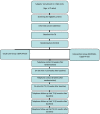Effect of a multicomponent exercise program and cognitive stimulation (VIVIFRAIL-COGN) on falls in frail community older persons with high risk of falls: study protocol for a randomized multicenter control trial
- PMID: 35870875
- PMCID: PMC9308197
- DOI: 10.1186/s12877-022-03214-0
Effect of a multicomponent exercise program and cognitive stimulation (VIVIFRAIL-COGN) on falls in frail community older persons with high risk of falls: study protocol for a randomized multicenter control trial
Erratum in
-
Correction: Effect of a multicomponent exercise program and cognitive stimulation (VIVIFRAIL-COGN) on falls in frail community older persons with high risk of falls: study protocol for a randomized multicenter control trial.BMC Geriatr. 2023 Jan 19;23(1):31. doi: 10.1186/s12877-022-03535-0. BMC Geriatr. 2023. PMID: 36658558 Free PMC article. No abstract available.
Abstract
Background: Falls represent important drivers of intrinsic capacity losses, functional limitations and reduced quality of life in the growing older adult's population, especially among those presenting with frailty. Despite exercise- and cognitive training-based interventions have shown effectiveness for reducing fall rates, evidence around their putative cumulative effects on falls and fall-related complications (such as fractures, reduced quality of life and functional limitations) in frail individuals remains scarce. The main aim of this study is to explore the effectiveness program combining an individualized exercise program and an executive function-based cognitive training (VIVIFRAIL-COGN) compared to usual care in the prevention of falls and fall-related outcomes over a 1-year follow-up.
Methods: This study is designed as a four-center randomized clinical trial with a 12-week intervention period and an additional 1-year follow-up. Three hundred twenty frail or pre-frail (≥ 1 criteria of the Frailty Phenotype) older adults (≥ 75 years) with high risk of falling (defined by fall history and gait performance) will be recruited in the Falls Units of the participating centers. They will be randomized in a 1:1 ratio to the intervention group (IG) or the control group (CG). The IG will participate in a home-based intervention combining the individualized Vivifrail multicomponent (aerobic, resistance, gait and balance and flexibility) exercise program and a personalized executive function-based cognitive training (VIVIFRAIL-COGN). The CG group will receive usual care delivered in the Falls Units, including the Otago Exercise Program. Primary outcome will be the incidence of falls (event rate/year) and will be ascertained by self-report during three visits (at baseline, and 6 and 12 weeks) and telephone-based contacts at 6, 9 and 12 months after randomization. Secondarily, effects on measures of physical and cognitive function, quality of life, nutritional, muscle quality and psychological status will be evaluated.
Discussion: This trial will provide new evidence about the effectiveness of an individualized multidomain intervention by studying the effect of additive effects of cognitive training and physical exercise to prevent falls in older frail persons with high risk of falling. Compared to usual care, the combined intervention is expected to show additive effects in the reduction of the incidence of falls and associated adverse outcomes.
Trial registration: NCT04911179 02/06/2021.
Keywords: Cognitive function; Falls; Fractures; Frailty; Physical exercise.
© 2022. The Author(s).
Conflict of interest statement
The authors declare that they have no competing interests.
References
Publication types
MeSH terms
Associated data
LinkOut - more resources
Full Text Sources
Medical


